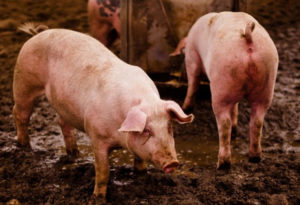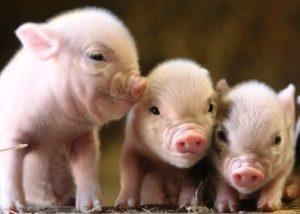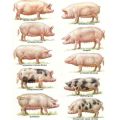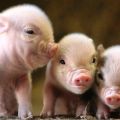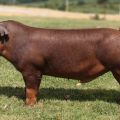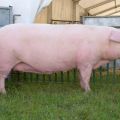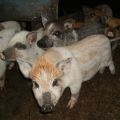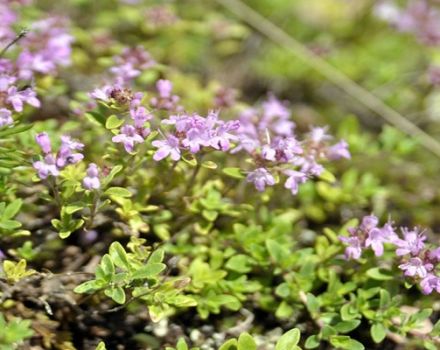Description and characteristics of the Yorkshire pig breed, breeding and care rules
Compared to other breeds, Yorkshire pigs have an increased prevalence around the world. These animals are the fourth most popular. Such a high demand is due to the good productivity of Yorkshire pigs. Boars of this variety are often used for crossing with representatives of other breeds.
Content
Origin
The Yorkshire pig appeared in the middle of the 19th century, was bred by a British farmer. However, Russian breeders met this animal after 10 years. The name of this variety of pigs was given by the place of residence of the breeder. Yorkshires were born by crossing the White Leicester and the English Long-eared. Also in pigs of this breed, the features of the Chinese variety are visible.
Characteristics and description of the breed
Yorkshires are distinguished by the following features:
- body weight reaches 350 kilograms (for sows - 250 kilograms);
- total length does not exceed 1.8 meters;
- massive chest;
- a flat stomach does not sag;
- large but short hams;
- flat back and compact, narrow-headed head;
- the skin is smooth with sparse white hair.
Yorkshires do not show aggression, including after the appearance of young animals. These animals can be kept with other livestock. Sows are characterized by abundant lactation, thanks to which adults are able to feed large offspring of piglets. Animals of this breed are characterized by resistance to common diseases and the ability to quickly gain weight. Sexual maturity occurs after one year.
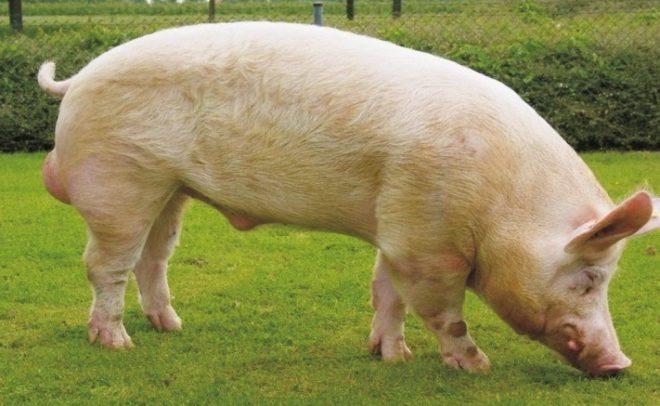
Advantages and disadvantages
Among the advantages of Yorkshire pigs, breeders highlight the following:
- increased content of premium meat (in particular, marble);
- can be fattened for quality bacon (lard);
- quickly reach large sizes (weight at 7 months reaches a centner);
- the ability to quickly adapt to new conditions;
- there are no feeding requirements;
- lack of pronounced aggressiveness;
- increased fertility;
- strong immunity to diseases in adults and piglets.
On average, new piglets weigh about 1 kilogram, regardless of the size of the litter. One month after birth, animals gain up to 20 kilograms. One sow is capable of producing up to 10-12 or more piglets. If slaughtered after 6 months, when the weight exceeds 100 kilograms, then the breeders receive a large amount of bacon production.

But this is not the main feature of the Yorkshire breed. Breeders, with proper feeding, are able to obtain a reference marbled pork, permeated with thin (up to 14 millimeters) layers of fat.
Among the disadvantages of the breed include skin that is sensitive to frost and high temperatures. This minus is leveled by the correct organization of the wintering and walking area.
How to choose the right piglets to buy?
When buying Yorkshire piglets, you should pay attention to the main signs that characterize healthy animals:
- large and heavy head with a straight profile;
- thin-walled ears;
- legs set straight with shiny hooves;
- the back and chest are wide;
- the belly does not sag, and there are no depressions on the withers;
- the tail is crocheted;
- when the jaw is closed, the upper teeth overlap the lower ones;
- absence of discharge on the anus;
- smooth, glossy coat that adheres tightly to pink skin;
- pink and wet nickel;
- breathing is deep and even;
- good appetite and increased activity.
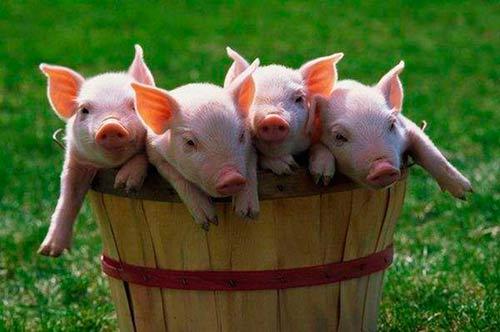
For a home farm, it is recommended to purchase monthly piglets whose weight has not reached five kilograms. It is advisable to buy pigs born in winter or early spring. In summer, animals are easier to feed. Piglets with a long back are considered the best. Such animals quickly gain weight.
Conditions of maintenance and care
It is recommended to keep animals of this breed in pigsties that meet the following characteristics:
- the minimum area of the premises is 5 square meters;
- the walls of the pigsty are upholstered with a thick and planed board, additionally insulated;
- the place for the animal's den is separated from the rest of the pigsty by a bar;
- pigsty height - at least two meters;
- a drinking trough is installed at the front wall;
- the piglet den is located near the sow's residence.
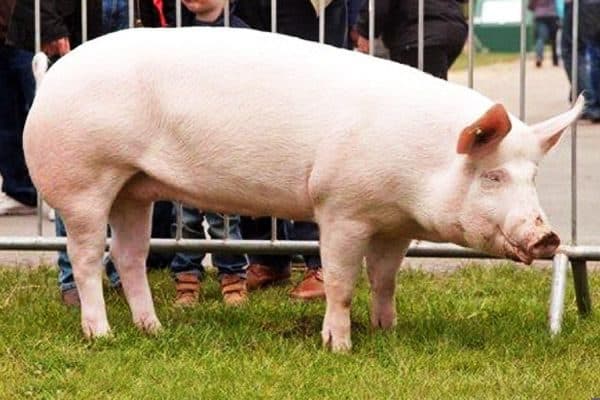
Despite the fact that Yorkshire pigs are unpretentious in care, a number of rules must be followed when keeping these animals:
- Pigs are highly sensitive to high and low temperatures. It is recommended to keep both adults and piglets in a covered room with good thermal insulation.
- Piglets tend to dig in hedges, while adults are capable of breaking the fence with their weight. This must be taken into account when organizing a walking area. To prevent the animals from leaving the pen, it is necessary to strengthen the fence.
- In summer, on sunny days, the walking area should be closed. Prolonged exposure to ultraviolet radiation is harmful to the skin of animals.
- Walking pigs in winter is allowed for no more than one hour. At the same time, you should not abandon this procedure either. Without sufficient walking, animal meat becomes tougher.
In addition, in order to prevent diseases of animals, it is necessary to periodically show the veterinarian and vaccinate against common pathologies.

Feeding pigs
To obtain high-quality meat, young animals are fed according to the following scheme:
- Up to 2.5 months, in addition to mother's milk, a small amount of boiled vegetables, chopped grass and cereals from crushed seeds, brought to a semi-liquid state, are introduced into the diet.
- Boiled vegetables, potatoes, fish bone meal, green and dried grass, kitchen waste are given up to 5.5 months. Piglets at this age should not gain more than 500 grams every day.
- Upon reaching 5.5 months of age, piglets are fattened using protein concentrates and legumes. The total daily weight gain during this period is 600-700 grams.
Adults are advised to give:
- Concentrated feed consisting of oats, corn and barley. It is also allowed to give compound feed and bran. All seeds must be thoroughly crushed.
- Juicy food such as potatoes, carrots and beets. The first one is served boiled. Carrots are recommended to be fed to sows and piglets. And beets can be given along with tops.
- Greenery. Pigs should be given nettles, quinoa, clover and peas in summer. Greens in the warm season are the basis of the diet.
- Animal feed, which includes fish and meat waste. It is recommended to give milk to young animals.
- Complementary feed. It can be other food waste and fungi.
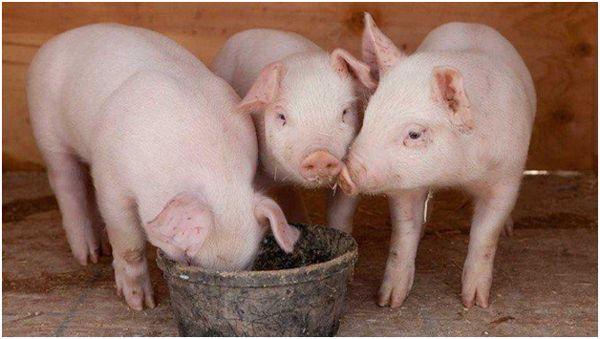
When feeding, bran and acorns are recommended to be supplemented with herbs and juicy feed. If this rule is not followed, then the pigs will develop constipation.
Breeding features
Sows reach sexual maturity by 12 months. A few days before the piglets appear, it is recommended to halve the amount of complementary foods. During this period, the sow begins to create a nest from the hay, and colostrum appears from the udder. 2 days before the expected farrowing of the animal, constant monitoring is necessary. Childbirth takes 1.5 to 6 hours. After emergence, each pig should be applied to the udder. If the pig is in an agitated state, then the young are placed in a separate box for 2-3 hours. Dispose of the umbilical cord after birth.
Fighting disease
Breeders of Yorkshire pigs are mainly faced with the development of rickets in young animals, the symptoms of which usually appear in the spring. Also, after winter, there are often signs of vitamin deficiency. In order to prevent these diseases, it is necessary to introduce spruce branches into complementary foods. If the conditions of detention are not respected, then the pigs develop atrophic rhinitis, which is indicated by snorting and frequent sneezing. The veterinarian should treat the latter disease.
What breed can be confused with Yorkshires?
Outwardly, Yorkshires resemble representatives of the Optimus and White English breeds. But the former differ in meat, which contains a small percentage of fatty layers.
Distribution of the breed in Russia
The Yorkshire breed is found mainly in the Volga region, in the North-West and Central regions. Pigs of this variety are more often purchased by large farms, which is explained by the high cost of young animals.
